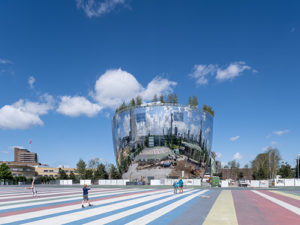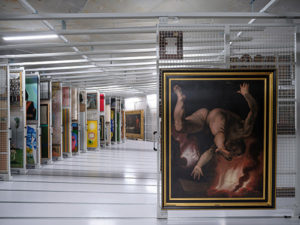On 6 November, the Depot Boijmans Van Beuningen in Rotterdam, designed by MVRDV, opens its doors. At the depot, everything revolves around the interaction between the visitors and more than 151,000 works that are stored in the various depositories. Visitors can – alone or in groups – take guided tours through the air-conditioned storage spaces or enjoy the rooftop forest and restaurant Renilde, both at a height of 35 metres. The opening marks the conclusion of almost a decade of work: MVRDV won the design competition in 2013, with construction starting in 2017. King Willem-Alexander of the Netherlands will perform the opening ceremony on Friday 5 November; the public is welcome from 10.00 am on Saturday 6 November.
The Depot Boijmans Van Beuningen is the first publicly accessible art storage facility in the world. The brief was to design a building that would be as inviting as possible, where all different target groups would feel welcome. It was emphatically not to become a second museum, where only a small percentage of the collection can be exhibited, but an engine room that reveals the world behind the storage and maintenance of a dazzling number of art and design works. Visiting the depot offers a completely new experience: the art is arranged according to size and climate requirements, not art history periods. Old and contemporary works are juxtaposed, inviting new connections to be made.
The MVRDV design team, led by architect and urban planner Winy Maas, opted for a round, sturdy, functional building that does not turn its back on its neighbours, instead establishing a new relationship with both the Museumpark and the city of Rotterdam. The ambition was to create a building that seems to disappear into its surroundings, but at the same time is a safe house for the collection, which is worth billions.
The depot owes its shape to the desire to give the building a relatively small footprint. As a result, the building takes up less space in the park, but curves upwards with a 10-metre overhang to accommodate the entire programme – storage spaces, restoration studios, catering facilities, and film and presentation rooms. The building has five climate zones to accommodate the most delicate art, from prints and paintings to photography.
The mirrored façade, consisting of 6,609m2 of glass divided into 1,664 panels, ensures that the building visually blends into its surroundings. The large entrance doors merge into the façade and only become visible during opening hours, when the façade opens up like a gadget out of a James Bond film. Every day – depending on weather conditions – the depot looks different, like a living painting.
Inside, the most eye-catching part of the building is the atrium, with its criss-crossing staircases and windows into the storage spaces that give the impression of a panopticon, with a view of the art from all sides. Thirteen large display cases ensure that the visitor comes into contact with a collage of collection pieces as soon as they enter the building. For the interior, there was close cooperation with a number of artists: John Körmeling designed the entrance and Marieke van Diemen designed the display cases. Outside, Pipilotti Rist designed a light installation that makes the depot come alive at night.
The depot is also an experiment in adding nature to the city. This takes place in the form of the 35-metre-high rooftop forest, which was awarded the prize for the best Dutch roof even before it opened. The 75 birches, grasses and 20 pines placed on the roof help retain water, promote biodiversity, and reduce heat stress in the city. The trees for this project were prepared for their new home for three years in a nursery. Their roots are interconnected and, because the windbreak and the cross-shaped restaurant on the roof protect the birches from strong winds, they will be able to withstand stormy weather even at a height of 35 metres.
“I think it’s great to see how the depot has been embraced by Rotterdammers even before it opened”, says MVRDV founding partner Winy Maas. “The depot is a building that makes many people happy; skaters have their own place outside that will hopefully stay, while passers-by try to figure out the best place to stand to take a good selfie. As an architect, I hope that visitors will soon enjoy the interior, the rooftop forest, and the experience of being in direct contact with the art without the mediation of a curator. Our ambition was to give the Museumpark a new dimension, and to bring different target groups, from schoolchildren to Feyenoord fans, into contact with the Boijmans collection in an innovative way. We hope to have added a new work of art to Rotterdam’s already rich architecture collection.”
“A good house is of vital importance. If you don’t have one, you are already playing in the second division. With the Depot Boijmans Van Beuningen, the amazing collection finally gets its own architecture”, say Sjarel Ex and Ina Klaassen, the directors of the Museum Boijmans Van Beuningen. “Only then do you see how the functioning of the art storage impacts the museum. With the depot, the museum is giving its collection, which is largely owned by the municipality but also largely by private individuals, a permanent future. Visitors can now see for themselves the love, care, and attention to detail with which each individual work of art is preserved for future generations. The museum, the public, and Rotterdammers are going to have a lot of fun with the depot.”
“The already iconic Depot Boijmans Van Beuningen is a wonderful asset to Rotterdam”, says Said Kasmi, Rotterdam’s Alderman for Education, Culture and Tourism. “The versatility of the building appeals to me: it is both a place to wander between a lot of great art, and a place to enjoy special architecture, whether you are outside or inside. Add to that roof restaurant Renilde, a wonderful place to enjoy a culinary highlight with a spectacular view over our city. Finally, it is a place where future makers and conservators – the children and students of today – can become fascinated by the creation, conservation, and restoration of art. We have a new crowd-pleaser. That makes me a proud Rotterdammer!”
Depot Boijmans Van Beuningen is a collaboration between Museum Boijmans Van Beuningen, the municipality of Rotterdam and the De Verre Bergen Foundation. The depot was designed by MVRDV and built by BAM Bouw en Techniek.
 Image: © Ossip van Duivenbode
Image: © Ossip van Duivenbode
 Image: © Ossip van Duivenbode
Image: © Ossip van Duivenbode
 Image: © Ossip van Duivenbode
Image: © Ossip van Duivenbode
